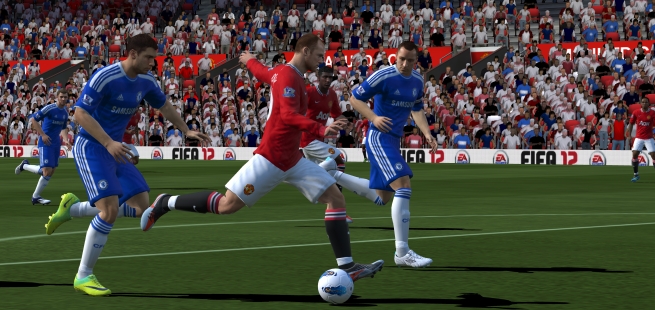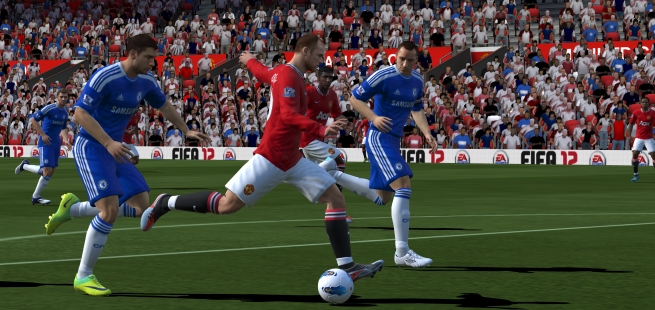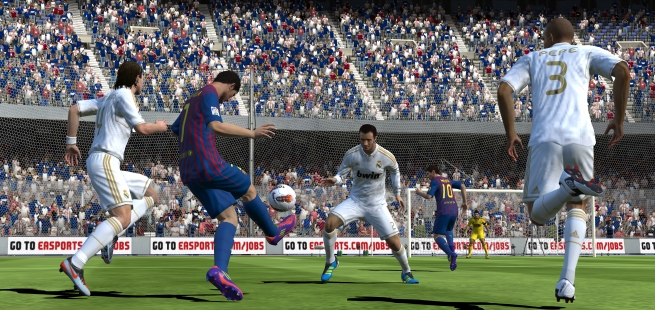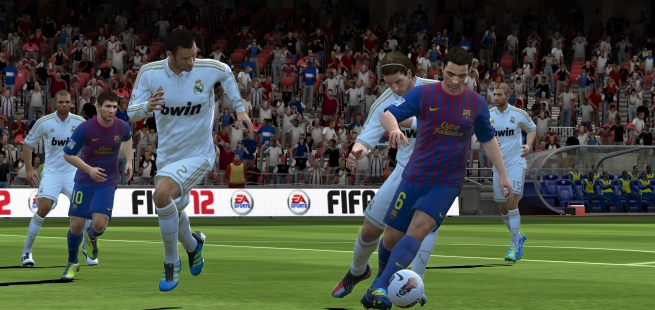EA Sports didn’t just drop a year number from the PlayStation Vita version of FIFA Soccer, a title that’s hugely important for the franchise’s success in portable form. While the developer made some omissions to simplify the intricacies of the console version, this is undoubtedly the most complete handheld iteration ever — not that the bar is set very high in this area.
For me, the previously released FIFA 12 didn’t only cement the series’ fanny to the soccer throne, it provided a marquee moment for virtual sports. The introduction of the Tactical Defending System, Precision Dribbling, and Player Impact System revolutionized the genre so thoroughly that it rendered Konami’s Pro Evolution Soccer efforts completely pointless. FIFA 12 was the result of sustained hard work and invention from EA’s dedicated team, a sacrifice that can be felt throughout each match.
Luckily, the franchise’s galvanization in quality hasn’t dampened the effectiveness of FIFA Soccer on Vita. The aforementioned “Holy Trinity” doesn’t make an appearance, but this never becomes a substantial problem. Dual-analog sticks allow for a slick game, as passes ping around the pitch with vigor. Your team constantly strives to find space, providing you with the means of unlocking even the most hardened defense. The default camera view is excellent when analyzing what ball you need to play next, providing peripheral vision that’s vital to success. The Vita scales proceedings down considerably but manages to replicate a sense of composure and pace that series aficionados will feel instantly comfortable with.
Successful FIFA players have always had to adapt their game from one iteration to the next, and this title is no different. While elements such as defending and dribbling aren’t as archaic as they were in FIFA 11, they lack the precision of the latest console release. Perfect timing isn’t needed to tackle, and the game won’t punish you too often for sticking a leg in at the wrong time. Stoppages are harder to come by, as retrieving the ball lacks any real risk. While your team shies away from instantly homing in on the player in possession (like they did in FIFA 11), you’ll never have to plan your defensive strategy to the extent of FIFA 12. The onus is placed on dealing with each situation as it arises, without any emphasis on pre-determined tactics or structure. Basic formations are needed to execute each gameplan, but you won’t be shoring up free space and jockeying the opposition to win every single ball.
The lack of defensive efficiency is a backward step, but it allows the Vita to show its strengths in other areas. Controls convert across well, with only a handful of slight alterations to learn. Due to the lack of trigger buttons, players now perform chip shots by clinking both the L+R buttons down together, an example that pinpoints how EA has overcome the limitations of the hardware. Although simple for the most part, dribbling runs into a few noticeable problems. Flicking the right stick in a certain direction still puts space between your player and the ball (a key skill for evading opposition in the console game), but it lacks accuracy and precision. I found it easier to pass around the defense rather than heading into a one-on-one conflict.
Utilizing Vita’s touchscreen and rear touchpad, FIFA Soccer’s most interesting inclusion is the arrival of an entirely original control scheme. Like in EA’s iPhone titles, you can pass the ball to any player by tapping his position. Fundamentally, this should work, but the Vita’s stocky size isn’t as conducive for this as Apple’s handheld, a system where such control is necessary. Instead, you’ll find yourself losing grip of the Vita and the match in front of you, rendering the inclusion as nothing more than a failed experiment.
The use of the rear touchpad is far more interesting. EA has cleverly doubled it up as a template for the goal you’re trying to penetrate, an application that sounds better than it works. If you want to plant a thunderbolt in the top corner, the idea is to poke Vita’s back in the corresponding place. Power is strengthened by holding your finger down for an extended amount of time, but as intriguing as this is, it never outshines the classic method of control.
Having the rear touchpad active during a match can also throw up persistent frustration, as you accidentally punt the ball away with the slightest of touches. This restricts how you hold the handheld even more, and I doubt many players will continue to use it after the novelty has worn off. It certainly represents a step in the right direction and an early indication as to what Vita could do with the series, but right now it isn’t fleshed out enough to be considered essential.
FIFA 12’s career mode is very much intact here, allowing you to cut it as a player, manager, or combination of both. It couldn’t be more pleasing to see EA has taken its content seriously, moving across all of the console game’s single-player modes. Transfer markets thrive throughout each career, rumors swirl, and your team has to be managed with a dedicated amount of care. Be-A-Pro also makes a welcome return, giving you the opportunity to build your very own rags-to-riches story. Your created player’s statistics can improve during any of the game’s single-player modes, from the 15-year career to the training arena that masks each loading screen. Everything is so instantly accessible and familiar that the only major differences show themselves on the pitch.
For all its single-player prowess, FIFA Soccer is lacking in a couple of multiplayer areas. Ultimate Team is the most noticeable absentee, somewhat surprising when you consider the massive push it’s received over the past year. Vita is perfect for such a mode, as the option to buy cards, improve squads, and build your fantasy club seems to go hand-in-hand with the device’s portability. If EA really had its minds in gear, Ultimate Team would have been included with PlayStation 3 connectivity. I want to be able to improve my team on the fly, return home, and challenge the world on my big screen. Right now this is an outlandish dream, much like my desire for England to bring home the 2014 FIFA World Cup.
Visually, this title does a decent job. Each player is suitably detailed and recognizable, and I urge you to use the instant replay’s zoom function to admire EA’s handiwork. From Carlos Tevez’s scars to David Beckham’s chiseled good looks, FIFA Soccer doesn’t fair much worse than its console cousin, in a static state at least. Once the action gets moving, each match flows solidly, especially for a first crack on Sony’s handheld. Replays don’t fair so well, highlighting choppy animation that isn’t spotted when the game is running at full speed. Definitely room for improvement but there aren’t too many complaints to be had at this point in time.
Conclusion
With a plethora of familiar modes and polished gameplay, FIFA Soccer is a comforting portable companion for fans of the sport. It sits between the slickness of FIFA 11 and grit of FIFA 12, forging a simple experience that acts as a welcoming introduction to Vita’s capabilities. As ever, EA has produced a thoroughly enjoyable and time-consuming addition to a series that continues to grow in popularity. Drawbacks aside, this is an accomplished and worthwhile addition to any soccer fan’s collection. Score: 75/100
FIFA Soccer was released for the PlayStation Vita on February 15, 2012. A copy of the game was provided by the publisher for the purpose of the review.
VentureBeat's mission is to be a digital town square for technical decision-makers to gain knowledge about transformative enterprise technology and transact. Learn More




